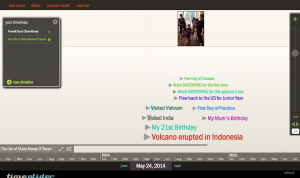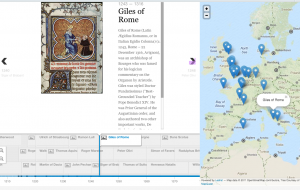If one were to think about it in the most lamest of illustrations, history without chronology would resemble a pot-luck stew. There would be no way of telling what was in there, nor in what order the individual components should be eaten to avoid, quite bluntly, food poisoning. This is why chronology is so important; it gives us a structured perspective on history.
As Grafton noted, historians in earlier years “organised diverse bits of historical information in the form of dated lists” and some chronologies even had the capacity to “tell us as much about its visions of past and future as do its historical narratives”. English scientist and theologian, Joseph Priestley expanded and somewhat disagreed with Grafton’s second point. Priestly believed that a “timeline was a ‘most excellent mechanical help to the knowledge of history,’ not an image of history itself.”
Priestly’s message is extremely relevant to the modules we have been experimenting with in class, Timeglider and TimeMapper, because they both demonstrate both the advantages and limitations of these modes of representation.
In the image below, a mode of representation can been seen with Timeglider. The information used for this example were events in my own life.

From the glaring red event, one can’t miss that a volcano erupted in Indonesia sometime in May of this year. A stranger observing this timeline may wonder “why would someone include a volcano eruption on their life timeline?”. The truth is that this event is quite significant to my life timeline because it in fact prevented me from returning home to Australia for 5 days since all flights were cancelled flying in and out of Singapore (a common transfer location onwards to Australia). That same stranger would have none of this knowledge from simply looking at the timeline below, he or she would have to click on the event in order to gain more information about the occurrence. This illustrates one limitation of Timeglider-and timelines in general- there is a limit to how much information can be on the timeline before it turns into “pot-luck stew”. Regardless, timelines can still be very informative if the central aim is to gain a sense of when events occurred and in what order.

In a different module, TimeMapper, we can see other benefits and limitations of a mode of representation. TimeMapper is an interactive timeline that connects events to a geomap. The example being used on TimeMapper is the timeline of Medieval Philosophers. Figure 2 demonstrates where Giles of Rome lived (Bourges, Italy) on the map alongside the timeline, and it also gives a summary of who he is and some famous occurrences in his lifetime. By scrolling through the timeline on the bottom of the TimeMapper screen, one can learn much about who the most famous Medieval Philosophers, where they lived and what made them historically renowned. Compared to Timeglider, a lot more information is presented on the timeline, however it is also trickier to navigate, in the sense that you probably need to know what you’re looking for in order to find it. If someone is more of a browser, then TimeMapper is their perfect match.
From the examples above it becomes clear that one mode of representation may fit a set of information more appropriately than another. Furthermore, that by experimenting with different modes of representation, a lot more valuable knowledge may be gained. To make these points clear, we must again revisit the idea of history without chronology resembling pot-luck stew; it is imperative that a mode of representation for historical information has some sort of timeline or chronology to give it structure. For as Grafton so perfectly notes, in some respects, chronologies held a higher respect that the study of history itself.
Comments
3 responses to “History without chronology…. Good luck………”
I really like the way you demonstrate the idea that “there is a limit to how much information can be on the timeline”, giving the example of volcano eruption. I wrote on my post that Timeglider implies the causalities of events (a storm at night and a power outage in next morning). However, having read your post, I have to admit that such interpretation can only be made when the reader has the knowledge that storm might lead to power outage. Even though you add an event “came back home 5 days later than expected” following the volcano eruption event, a reader who doesn’t know “Singapore is a common transfer location onwards to Australia” still cannot interpret the causality of these two events.
Very great work. I agreed with what you had to say in my blog post earlier. TimeMapper is better than TimeGlidder, but it does limit the word count for the description of the event, which is its Achilles heal. The only really big difference is being able to put a location on events, which happens in TimeMapper, making it superior. My only suggestion for your blog would be to try to work the text around the pictures and giving the pictures more of a description, other than that though, awesome work!
Claire, I found your first paragraph to be both informative and comical. Your descriptive use of imagery allowed me to visualize and understand exactly what you were talking about. Your blog was definitely lengthy, however, the fact that it kept the reader continually informed and interested, in a way disregards the length of it. You were not spitting out junk, and that is important.